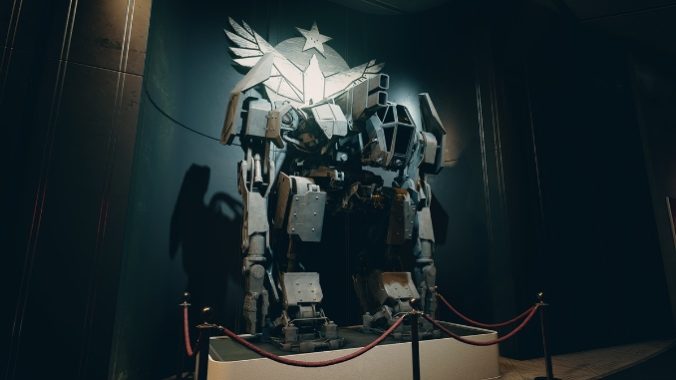How Museums in Starfield and Fallout Reveal the Politics of History

I’ve been fixated on what Starfield says about history as political construction since first landing on the hub planet Jemison and starting the questline for the privateer navy known as the U.C. Vanguard. I was delighted to interact with each museum exhibit on the way to the flight simulation test, drawn to observe how the United Colonies crafts history. The U.C. are the heirs to Earthly governments, an apparent liberal democracy interstellar power with a crucial similarity with the fascist United Citizens Federation from 1997’s Starship Troopers: citizenship is bestowed only to members of the military and bureaucracy, which contributes to recruiting their freelance navy. Touring the museum and seeing the heroic presentation of the U.C. in military conflicts, its claim to earthly provenance (most apparently modeled on the U.S.), and its competitors (the cowboy-libertarian Freestar Collective and the enigmatic theocracy House Va’ruun) made me think there might be some edge to the apparent optimism of Starfield’s “NASA-punk” aesthetic. Bethesda is interested in how society shapes memory through shared stories and the thin, blurry lines between history and propaganda.
In Imagined Communities: Reflections on the Origin and Spread of Nationalism, Benedict Anderson argues, among other things, that nations are social constructs arising like broad kinship groups, with nationalism partially displacing religion rather than operating solely as ideology, shaped in large part through language and print. The first revised edition goes on to include museums among its expanded look at visual and institutional development. The Fallout games show both how museums can be used in the process of nation-building and how movements and peoples draw on heritages and imagined lineages to cultivate meaning in their lives. They also confer how difficult the past is to know without an unbroken chain of records, the sort irreparably damaged by global nuclear war.
In Fallout 3, at the Capitol/Capital Preservation Society in Rivet City of southeast Capital Wasteland, eager public historian Abraham Washington misquotes the U.S. Founding Fathers while fetishizing artifacts like Abe Lincoln’s top hat. In speculating to fill knowledge gaps left by archival record holes, Washington exemplifies both the difficulty of trying to historically reconstruct a dead civilization and how preconceptions shape the process. His computer document guide lists the writing of the Constitution and the Emancipation Proclamation one year early (1786 instead of 1787 and 1862 instead of 1863, respectively) and there is ironic triumphalism embedded in the museum computer’s statement that the “Thirteenth Amendment of the Constitution…completely abolished slavery once and for all” considering not just real-world American history from the late 19th century to the 21st, but also that there is slavery in the 23rd century Capital Wasteland. Washington believes Constitutional Amendments were “modifications made to the articles by ruling Presidents during their reigns,” unaware of the process by which laws were passed, setting aside the autocratic connotations of “ruling” and “reign.” Washington gets the date on the Gettysburg Address correctly, and quotes Lincoln’s description of government “by the people, for the people” as the basis of democracy in the United States, a perhaps unwitting historical argument about the Address establishing that goal rather than fulfilling the alleged aspirations of the Founders.
In Fallout: New Vegas (published by Bethesda but developed by now-sibling studio Obsidian), Freeside gang “The Kings” represent this kind of misremembering by modeling themselves on Elvis Presley’s aesthetic persona without knowing his music or real name. In Fallout 3, the Enclave claims its authority through its connection to the government of the fallen U.S. (not entirely dissimilar to the U.C.). In New Vegas, Caesar’s Legion models its society on Roman brutality, showcasing miseries of ancient life without the glamor real life representation tends to loft upon Rome, though still haughty about the project. Simultaneously, the ruling families of New Vegas were Wasteland clans handpicked by Mr. House, given casinos to run and clothes to match as the Howard Hughes lookalike remade the city in his image. In Fallout 4, the groups known as The Railroad and the Commonwealth Minutemen both use their names to draw connections between their missions (freeing enslaved androids and serving the Commonwealth as a volunteer militia, respectively) and U.S. history.